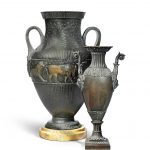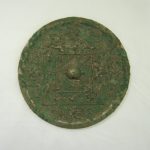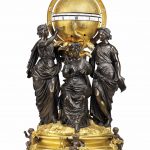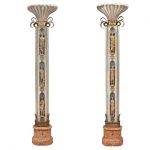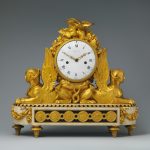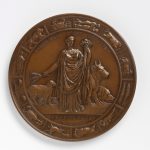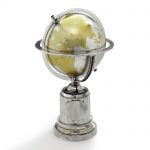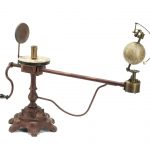Antique Bronze Astrological Metalware. Bronze is an alloy consisting primarily of copper, commonly with about 12–12.5% tin and often with the addition of other metals (such as aluminium, manganese, nickel or zinc) and sometimes non-metals or metalloids such as arsenic, phosphorus or silicon. These additions produce a range of alloys that may be harder than copper alone, or have other useful properties, such as stiffness, ductility, or machinability.
The discovery of bronze enabled people to create metal objects which were harder and more durable than previously possible. Bronze tools, weapons, armor, and building materials such as decorative tiles were harder and more durable than their stone and copper (“Chalcolithic”) predecessors. Initially, bronze was made out of copper and arsenic, forming arsenic bronze, or from naturally or artificially mixed ores of copper and arsenic, with the earliest artifacts so far known coming from the Iranian plateau in the 5th millennium BC. It was only later that tin was used, becoming the major non-copper ingredient of bronze in the late 3rd millennium BC.
A French 19th century bronze urn Of classical shape, with scrolled handles issuing from lion masks; together with a bronze urn of Classical design, decorated with a band of astrological lions and bulls on a Siena marble circular base, 16cm wide, 9.5cm deep, 30cm high (6in wide, 3 1/2in deep, 11 1/2in high) and 41cm high (2)
Sold for £ 484 inc. premium at Bonhams in 2018
Mirror. Zodiac animal and celestial beings. Made of bronze.
Reference: © The Trustees of the British Museum
A LARGE LOUIS PHILIPPE GILT AND PATINATED-BRONZE PENDULE A CERCLES TOURNANTS CIRCA 1840 Modelled as three classical figures supporting a globe surrounded with a band with symbols of the zodiac and set with with turning dials, on a base set with three putti emblematic of the arts and sciences, the dial inscribed ‘Ferdinand Berthoud / Paris’ 41 ½ n. (105.5 cm.) high
Sold for GBP 47,500 at Christies in 2017
Pair of Art Deco Parcel Gilt Bronze, Metal and Marble Torcheres 1940s Decorated with signs of the Zodiac, unmarked. Height 6 feet 6 inches, width 17 inches.
Sold for $6,250 (includes buyer’s premium) at Doyle New York in 2018
VIKING LUNAR/ASTROLOGICAL PENDANT C.850-950 AD
Gilt bronze, just under 1″ width. Elegant slender form tapering to the terminals. Possibly representing an auspicious phase as new moon. As expert navigators, the constellations signified mystery and power to Vikings. Lunar pendants were worn as pectorals as well as suspended from belt.
Sold for $150 at Jasper52 in 2019
Mantel clock (pendule de cheminée),ca. 1783 Designed by François Joseph Belanger French
Its movement resting on a tasseled cushion placed on the backs of two winged sphinxes? The cresting of the case alludes to love: a pair of billing doves perches on clouds from which spill flowers, mostly roses and myrtle branches, both sacred to Venus. The sphinxes recline on a white marble base with semicircular ends that are embellished with garlands of fruit and flowers. The recessed tolework panel in front encloses medallions depicting six of the twelve zodiac signs. With their striated wigs, the sphinxes are expressions of the budding interest in a novel form of decoration inspired by art from ancient Egypt.
Reference: The Metropolitan Museum of Art
Table clock German (Augsburg) about 1625–50 Unidentified artist
Astronomical quarter striking astrolabic and zodiacal table clock. Gilt with astronomical & astrological dials on four sides, of silver with blue, orange & green enamel. Two bells in top. Frame engraved with scrolls & fruit, medallions on two sides of base; vases on two ends under dials, and landscapes on front and back. Musical mechanism added above gallery on top. This elaborate clock in the form of a building is as much a precious work of art as a complicated scientific instrument. Dials on this side record the time of day and night, days of the week, months, seasons, signs of the zodiac, and the date according to an ancient Roman calendar. The other side measures astronomical time and the position of the sun and moon at various times of day. Additional dials allow one to set an alarm and regulate the striking of hours and quarter hours. Such complex mechanisms were awe-inspiring wonders of their day. The ability to measure the known universe with man-made machines was a potent demonstration of its owner’s knowledge, power, and wealth.
Reference: Museum of Fine Arts Boston
PTOLEMAIC GILT BRONZE ARMILLARY SPHERE WITH EARLY, POSSIBLY 16TH CENTURY, ENGRAVED GLOBE 16 inch tall, 9 1/2 inch diameter gilt bronze armillary sphere on turned wood stand, ca 1780. Horizon ring engraved with the names and signs of the zodiac in Latin, ecliptic ring divided into 12 equal parts with the signs of the Zodiac named in Latin alongside the figurative representation of each constellation and divided every 1 degree. Inside the primary sphere are two movable systems of rings fixed perpendicular to each other, representing the orbits of the Sun and the Moon. At center of sphere is a finely engraved 1 1/2 inch early bronze globe, depicting Antarctica as “NOVA GUINEA” and with a very elongated and narrow North American continent.
Sold for 11,875 USD at Sothebys in 2018
Bronze struck medal: The Cattle Market and Slaughter Houses of Paris, signed and dated 1872. This medal celebrates the buildings of the cattle market and abbattoirs of Paris. The signs of the zodiac representing the months of the year border the figure of plenty.
This is a bronze struck medal made in France, 1872. The medal was designed by Louis Merley (1815-1883) and made to celebrate the buildings of the cattle market and slaughter houses of Paris. The signs of the zodiac representing the months of the year border the figure of Plenty.
Reference: © Victoria and Albert Museum
